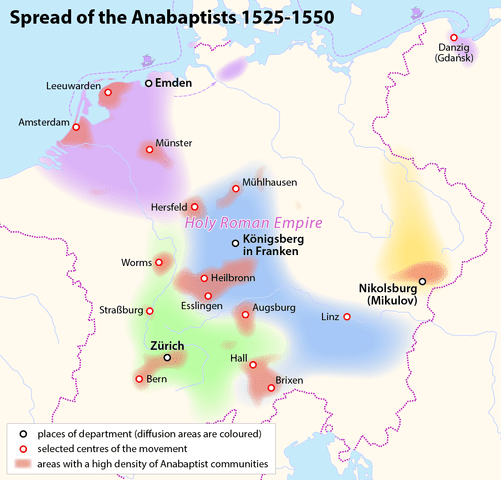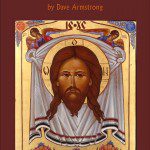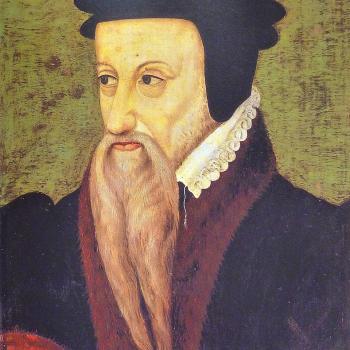James Swan (“TertiumQuid”), webmaster (Boors All + Facebook page), anti-Catholic Reformed Protestant polemicist and longtime defender of Martin Luther (sometimes rightly) against what he sees as a torrent of Catholic misinformation and bigotry, wrote on the Catholic Answers Internet forum on 17 August 2014 (comment #347 in a long thread):
I’d like to have some clarification on this point, if possible. I don’t recall Luther being elected to political office or having a political reign in Wittenberg. As far as I know, he was an influential preacher and a theologian in Wittenberg in an age in which the church and state had a close relationship. Nor do I recall Luther specifically having individuals executed in Wittenberg in the 1530’s. I am aware of some people being executed for witchcraft in Wittenberg in the early 1540’s, and I’m familiar with the severe interrogations of some Anabaptists in Wittenberg in the 1530’s.
As someone always willing to learn (or to be reminded of what I’ve forgotten), I’d like to know (or be reminded) exactly who Luther had executed in Wittenberg in the 1530’s. While it certainly is within the realm of possibility that the secular authorities of Wittenberg during the 1530’s carried out capital punishment, I don’t recall this actually happening in the 1530’s, or more specifically, that Luther was involved with the carrying out of executions during the 1530’s, especially against Anabaptists.
Thanks.
I’m always happy to assist Mr. Swan in his yearning to achieve knowledge of historical facts. I’ve been doing it these past twelve years; no need to stop now. I wrote a paper over ten years ago now, documenting Luther’s sanction of the death penalty for Anabaptists (including peaceful ones). He advocated this specifically by signing in assent pamphlets written in 1531 and 1536 by his right-hand man Philip Melanchthon. In my paper, I cite famous Luther biographer Roland Bainton at length, corroborating this. That’s the background. We know (beyond dispute) that he (and Melanchthon and others in Wittenberg) favored this intolerant approach in the 1530s.
Swan is asking, however, for documentation that executions actually occurred there during that decade. This is more difficult to document, but without too much trouble I ran across some documentation via Google Books. It comes from a work entitled, Valentin Weigel (1533-1588): German Religious Dissenter, Speculative Theorist, and Advocate of Tolerance (Albany: State University of New York Press, 2000), written by Andrew Weeks, who is a Professor of Languages, Literatures and Cultures at Illinois State University. He writes:
Of the various studies of Reformation-era intolerance, those of [Paul] Wappler and [Nikolaus] Paulus document conditions in Saxony . . . In Luther’s part of Saxony, there were executions for the offense of rebaptism as early as 1527 (before the imperial mandate of 1529), and afterward in the years 1530, 1532, and 1538. [60] Unlike the milder regime in Hessen, where as a rule only the openly rebellious dissenters were sentenced to death, the Wittenberg reformers soon came to support capital punishment even against peaceful heretics. [61] (p. 22)
There is evidence that as early as November 1529 Luther and Melanchthon sanctioned the death penalty for Anabaptists in an opinion to their Elector in response to the imperial mandate. [69] (p. 24)
By 1536, Luther, Bugenhagen, and Cruciger were advising Landgraf Philipp of Hessen to execute by the sword any Anabaptists apprehended in his territories. [74] Melanchthon was frankly encouraging capital punishment for heresy with or without rebellion. [75] (p. 25)
Weeks cites Wappler’s conclusions in 1908 about this state of affairs:
A progressively weakening police-churchdom and a repulsive system of denunciation and spying in the Lutheran church were the necessary outcome.” (p. 25; apparently the author’s translation of the original German)
Weeks notes an execution of a person in Saxony in 1535:
. . . the unfortunate shoemaker Peter Pestel, . . . neither preached his views nor performed baptisms in Saxony, [but] he is tried and executed mainly on the grounds of his denial of the Lutheran doctrine of the Eucharist [Dave: which views Melanchthon himself later denied] and the birth of Jesus from Mary. (pp. 27-28)
Unfortunately, I can’t access the footnotes from the Google Books edition of this book, and both Paulus and Wappler wrote in German, so I can’t get at further details of these executions from those sources. But if a professional historian cited them for documentation and gave footnotes, we can be fairly assured that this is solid evidence for executions of Anabaptists in Saxony, including Wittenberg, in the 1530s. And I offer further hard evidence below (read on).
We do have one person mentioned by name in Weeks’ book: Peter Pestel. The Global Anabaptist Mennonite Encyclopedia Online provides an article about him and more detail:
. . . on 23 April 1536, he was arrested and taken to the castle in Zwickau, and on the next day subjected to a cross-examination in the presence of the clergy (Wappler, p. 76). He confessed himself definitely as committed to Anabaptist teaching, and could not be deflected from his faith even by torture; “He would give his life for it.” He said he had neither preached nor baptized, but where it was suitable he testified to his faith and reproved “his fellow men of sin”; he vigorously denied that he or his companions had stirred up revolt, conspiracy, or sedition. Then he was given Melanchthon’s booklet, Verlegung etlicher unchristlicher Artikel Welche die Widderteuffer fürgeben (Wittenberg, about 1536), which had appeared at the same time as the electoral mandate. After reading it he gave the jailer the reply that there was not a true word in the booklet, . . . This state of affairs was reported to Johann Friedrich I, Elector of Saxony, who turned the records over to the court in Wittenberg with the request that they pass the sentence. . . . The elector, . . . drew up the death sentence himself and sent it to Zwickau, to the effect that Peter Pestel should be executed with the sword, in accord with the edict of Speyer of 1529.. . . The sentence was carried out on 16 June 1536, in Zwickau.
[one of two sources provided: Wappler, Paul. Inquisition und Ketzerprozesse in Zwickau zur Reformationszeit. Leipzig, 1908: 70-84]
Zwickau is in the southwestern region of Saxony: 160 km (99 miles) from Wittenberg. The real “goldmine” of documentation in English comes from the same Encyclopedia, in its article on Saxony. It cites Wappler and Paulus as well, as two of its three sources from historians:
Early in February 1527, in the district of Königsberg, a Saxon enclave in Würzburg territory, where the movement gained an early foothold through the efforts of Hans Hut, Volk Kolerlin, and other Anabaptist apostles, the first Anabaptists were seized. On 26 February 1527, the elector issued the public order, “that no one, be he citizen, peasant, or anyone else, except the regular clergyman, preacher, and chaplain, to whom pastoral care is entrusted and who is qualified at each place is permitted to preach, baptize, or exercise other similar offices in his house or other places owned by him.” Soon afterward he had the Königsberg citizens, Beutelhans, Wolf Schominger (Schreiner), and ten other men besides a woman put to death as Anabaptists.. . .
The Saxon reformers approved of the elector’s violent measures, so that on 23 April 1529, at Speyer he could without qualms of conscience give his consent to the well-known Anabaptist mandate (see Punishment of the Anabaptists) and henceforth strove to act in accord with it.
In 1529 ten Anabaptists were imprisoned at Reinhardsbrunn, and the six who remained steadfast were put to death on 18 January 1530, causing great excitement among the people. The reformers now found it advisable to formulate a vindication of the right to punish heretics. To this end Justus Menius, the superintendent of Eisenach, wrote Der Widdertauffer lere und geheimnis aus heiliger Schrjft widderlegt, with a preface by Luther and a dedication to Philipp of Hesse (who, they were convinced, was too lenient), dated 4 May 1530; and Melanchthon drew up a formal opinion addressed to the elector of Saxony at the end of November 1531.
In a long-drawn-out dispute with Philipp concerning the penalizing of several Anabaptists in the Hausbreitenbach district, which was under the joint jurisdiction of Saxony and Hesse, the elector insisted on their execution. In the end the prisoners were divided between Saxony and Hesse. Of those allotted to the elector at least three were put to death: Berlet Schmidt, Hans Eisfart, and his wife. Later he also insisted upon the execution of the Anabaptist leaders, Melchior Rinck and Fritz Erbe, who were held by Philipp. They died in prison.
In Schweinitz near Wittenberg death in prison terminated the many cross-examinations and long martyrdom of Hans Sturm of Steyer, though he had neither preached nor baptized in Saxony. His countryman Peter Pestel of Linz, also a victim of the intolerance of the Wittenberg theologians and jurists, was beheaded on Friday after Corpus Christi at Zwickau in 1536.
After the fall of Münster in 1535 the elector’s severe attitude was, of course, sharpened. On 21 November 1535, Hans Peissker of Kleineutersdorf near Orlamünde was arrested in his own house with his sixteen-year-old daughter Margarethe and fourteen others; he was taken to the Leuchtenburg, and after a minute cross-examination, attended by Melanchthon, put to death with Heinz Kraut and Jobst Möller in Jena at the end of January 1536. Of the four prisoners who were transferred to Neustadt an der Orla because of lack of prison space in the Leuchtenburg, Heinrich Möller sealed his faith with his death.
On 10 April 1536, a new mandate was issued in Saxony against the “Anabaptists, Sacramentists, and fanatics,” which was composed by Melanchthon, and also a polemic from the same pen, Verlegung etlicher unchristlicher Artikel, welche die Wiederteuffer furgeben, which every pastor in Saxony had to read and explain to his congregation on each third Sunday.
In January 1538 the elector had two men executed who were caught conversing with Fritz Erbe in the tower of the city wall of Eisenach, and who persisted in their faith in spite of all efforts to convert them. They were Hans Köhler of Eyerode and Hans Scheffer of Hastungsfelde. Other admirers of Erbe recanted on the rack.
In the territory of Mühlhausen, an imperial city, where after the Peasants’ War in 1525 the Duke of Saxony had the protective magistracy every third year alternating with the elector of Saxony and the langrave of Hesse, Georg Köhler and Klaus Ernfart were among those who suffered death. A large number of Anabaptists were drowned in the Unstrut between Mühlhausen and Ammern and buried on the bank; among these were Jakob Storger and Klaus Scharf besides eight women on 8 November 1537, and Hans Hentrock of Amra and Ottilia Goldschmidt, a Mühlhausen girl, on 17 January 1538.
James Swan was unaware of all this. Now (if he can make it through this paper by a despised papist apologist) he is aware. He asked: “I’d like to know (or be reminded) exactly who Luther had executed in Wittenberg in the 1530’s.” The answer is in the above article, partially corroborated by historian Andrew Weeks in his book and drawn (in both cases) from the German historians Paul Wappler (Lutheran) and Nikolaus Paulus (Catholic). I’ll make it even more simple by the following list of Anabaptists executed in Saxony (incorporating information from further articles in this Encyclopedia about the Anabaptists involved):
1) “Beutelhans, Wolf Schominger (Schreiner), and ten other men besides a woman” were beheaded in the district of Königsberg, a Saxon enclave in Würzburg territory: March 1527. [13]
2) Six Anabaptists (Andreas and Katharina Kolb, Christoph Ortlep, Katharina König, Elsa Kuntz, and Barbara Unger) were imprisoned at Reinhardsbrunn and put to death on 18 January 1530. [6]
3) Berlet Schmidt, Hans Eisfart, and his wife, in the Hausbreitenbach district, which was under the joint jurisdiction of Saxony and Hesse; in 1532. [3]
4) Georg Köhler and an Anabaptist woman at Sangerhausen in the territory of Mühlhausen in September 1535. [2]
5) Hans Sturm of Steyer: 1535(?) or 1536(?) in Schweinitz near Wittenberg. [1]
6) Hans Peissker of Kleineutersdorf, after a minute cross-examination, attended by Melanchthon, was beheaded with Heinz Kraut and Jobst Möller in Jena on 26 January 1536. [3]
7) Heinrich Möller at Neustadt an der Orla, c. February 1536. [1]
8) Peter Pestel of Linz was beheaded on 16 June 1536 in Zwickau. [1]
9) Klaus Ernfart in 1536. [1]
10) Jakob Storger and Klaus Scharf besides eight women drowned in the Unstrut between Mühlhausen and Ammern on 8 November 1537. [10]
11) Hans Hentrock of Amra and Ottilia Goldschmidt, a Mühlhausen girl, drowned in the Unstrut between Mühlhausen and Ammern on 17 January 1538. [2]
12) Hans Köhler of Eyerode and Hans Scheffer of Hastungsfelde, at Eisenach, at the end of January 1538. [2]
By my reckoning, that is 45 people killed in Lutheran Saxony for the “seditious” crime of being an Anabaptist, between 1527 and 1538.
Swan would probably retort by saying that none of these seem to have been in Wittenberg itself. But that is an irrelevancy. They were carried out under Lutheran auspices, in Saxony: Luther’s home ground and the initial base of Lutheranism, with the direct assent and approval of Luther and Melanchthon. Where, specifically, the executions took place is entirely secondary to those considerations.
ADDENDUM
Indeed there were executions in Saxony. Search out these sources:
Valentin Weigel, German Religious Dissenter, Speculative Theorist, and Advocate of Tolerance
John S. Oyer, Lutheran Reformers Against Anabaptists
Peter Pestel, The Global Anabaptist Mennonite Encyclopedia
We do have one person mentioned by name in Weeks’ book: Peter Pestel. The Global Anabaptist Mennonite Encyclopedia Online provides an article about him and more detail:
Now, this may seem like my nitpicking or piling on, in a case of a simple mistake or human error. Readers may wonder why I am making such a “big deal” about it. I do precisely because Swan is always pointing out human errors in Catholic works (he’s noted real or — usually — falsely alleged — ones in my writings for twelve years). If a Catholic had made such an embarrassing error like this, we can be sure Swan would have trumpeted it from the rooftops as yet more evidence that we don’t know how to properly cite a source, and that we’re always trying to lie about and misrepresent Luther; that we’re, well, kind of dumb, and that we know nothing about context in reading and citing sources. He’s noted this many hundreds of times.
So here he is trying to pass himself off as an expert by naming three sources about Luther and the Anabaptists. He drew two of the three from me, in this very article, without noting that fact, and then attributes the editorship of one to one of the Anabaptist martyrs I wrote about above. It’s absolutely classic Swan antics and foibles.
He did not however document the “direct assent and approval of Luther and Melanchthon.” We don’t have a signed and sealed note from Luther saying “Ja, getten Sie diese Muttonheads! Love und Kuessen, Martin.” So I think the proof is somewhat lacking and is speculative. Did Luther control secular events in Wittenberg? That is probably unproveable at this point. I don’t think the point can be pressed either way, that Luther directed killing or that he had nothing to do with it. I call it murky.
Thus, Peter Pestel (as documented above; i.e., the martyr who supposedly edited a Mennonite Encyclopedia almost 500 years after his murder by Lutherans) was given Melanchthon’s notorious 1536 pamphlet (signed and agreed with by Luther) to read in prison. Upon rejecting it, the Elector decided that he was worthy of death, and he was executed.
That is one disproof of what “Tomyris” thinks is an unclear or “murky” issue. If that’s not clear enough “direct assent and approval” (my words) of such executions, then we have the evidence of Melanchthon being physically present at one of these monkey trials of Anabaptists, which I noted (thus “Tomyris” shows that he, like Swan, has the greatest difficulty reading my paper, which he himself cited and linked to). The Mennonite Encyclopedia article on “Saxony” stated:
On 21 November 1535, Hans Peissker of Kleineutersdorf near Orlamünde was arrested in his own house with his sixteen-year-old daughter Margarethe and fourteen others; he was taken to the Leuchtenburg, and after a minute cross-examination, attended by Melanchthon, put to death with Heinz Kraut and Jobst Möller in Jena at the end of January 1536.














